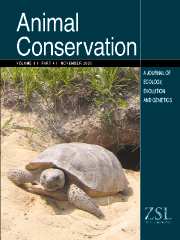Article contents
Ecological correlates of the threat of extinction in Neotropical bird species
Published online by Cambridge University Press: 11 May 2004
Abstract
Predicting the threat of extinction aids efficient distribution of conservation resources. This paper utilises a comparative macroecological approach to investigate the threat of extinction in Neotropical birds. Data on ecological variables for 1708 species are analysed using stepwise regression to produce minimum adequate models, first using raw species values and then using independent contrasts (to control for phylogenetic effects). The models differ, suggesting phylogeny has significant effects. The raw species analysis reveals that number of zoogeographical regions occupied, elevational range and utilisation of specialised microhabitats were negatively associated with threat, while minimum elevation and body mass were positively associated, whereas the independent contrasts analysis only identifies zoogeographical regions as important. Confining the analysis to the 582 species restricted to a single zoogeographical region reveals elevational range and number of habitats occupied to be negatively correlated with threat whether the analysis is based on the raw data or on independent contrasts. Analysis of four contrasting zoogeographical regions highlights regional variation in the models. In two Andean regions the threat of extinction declines as the elevation range across which the species occurs increases. In the presence of substantial human populations on high Andean plateaus, a species with a greater elevational range may be more likely to persist at some (relatively) unsettled altitudes. In Central South America, the strongest predictor of threat is minimum elevation of occurrence: species with a lower minimum are less threatened. The minimum elevation result suggests that lowland species experiencing an ecological limit to their minimum elevation (min. elevation >0 m) may be more at risk than those not experiencing such a limit (min. elevation = 0 m). Finally, in southern Amazonia, where there is little altitudinal variation, the only weak predictors of threat are body size, larger species being more threatened, and number of habitats, species occupying more habitats being less threatened. These contrasting results emphasise the importance of undertaking extinction risk analyses at an appropriate geographical scale. Since the models explained only a low percentage of total variance in the data, the effects of human-mediated habitat disturbance across a wide range of habitats may be important.
- Type
- Research Article
- Information
- Copyright
- 2004 The Zoological Society of London
- 32
- Cited by


